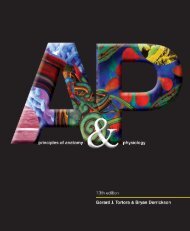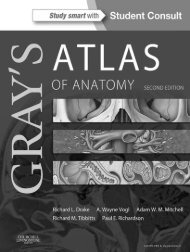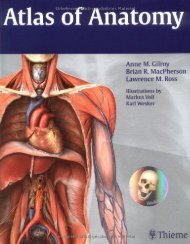theanatomyandphysiologylearningsystem4epdfdr-150930024720-lva1-app6891
You also want an ePaper? Increase the reach of your titles
YUMPU automatically turns print PDFs into web optimized ePapers that Google loves.
Chapter 2 Chemistry, Matter, and Life 29<br />
each type of atom must be the same in both the reactants and<br />
the products; that is, the equations must be balanced. In the<br />
above example, there is 1 carbon atom in the reactants and<br />
1 carbon atom in the products. There are 4 hydrogen atoms<br />
and 4 oxygen atoms in the reactants and the same number<br />
in the products. Because changing a subscript in a formula<br />
indicates a different type of molecule, equations can be balanced<br />
only by adjusting the numerals before the molecular<br />
formulas.<br />
The reaction between glucose and oxygen is an important<br />
one in the body. It provides much of the energy needed for<br />
body processes and daily activities:<br />
C 6<br />
H 12<br />
O 6<br />
+ 6O 2<br />
→ 6CO 2<br />
+ 6H 2<br />
O<br />
Glucose Oxygen Carbon dioxide Water<br />
This balanced chemical equation indicates that 1 molecule of glucose<br />
reacts with 6 molecules of oxygen to yield 6 molecules of carbon<br />
dioxide and 6 molecules of water. It is balanced because there<br />
are 6 carbon atoms, 12 hydrogen atoms, and 18 oxygen atoms on<br />
both the reactant and the product side of the equation.<br />
Types of Chemical Reactions<br />
Synthesis Reactions<br />
When two or more simple reactants combine to form a new, more<br />
complex product, the reaction is called synthesis, combination,<br />
or composition. These are the anabolic reactions in the body.<br />
This is represented symbolically by the following equation:<br />
A + B → AB<br />
For example, oxygen and hydrogen combine to form water<br />
in a synthesis reaction. Two simple molecules combine to form<br />
a more complex molecule as indicated in this equation:<br />
2H 2<br />
+ O 2<br />
→ 2H 2<br />
O<br />
When two simple molecules combine to form a more complex<br />
molecule by the removal of water, the reaction is called dehydration<br />
synthesis. Many anabolic reactions in the body, for example,<br />
the conversion of glucose to glycogen for storage, are of this<br />
type.<br />
Decomposition Reactions<br />
When the bonds in a complex reactant break to form new,<br />
simpler products, the reaction is decomposition. In the body,<br />
these are the catabolic reactions of metabolism. When water is<br />
used to break the bonds, the reaction is called hydrolysis. The<br />
digestion of food involves hydrolysis reactions. Decomposition<br />
reactions, represented symbolically by the following equation,<br />
are the reverse of synthesis reactions:<br />
AB → A + B<br />
Single Replacement Reactions<br />
Single replacement reactions, also called single displacement<br />
reactions, occur when one element in a compound is replaced<br />
by another. The general pattern for this type of reaction is represented<br />
symbolically as follows:<br />
A + BC → AC + B<br />
Double Replacement Reactions<br />
Double replacement reactions (also called double displacement<br />
or exchange reactions) occur when substances in two<br />
different compounds replace each other. These reactions are<br />
partially decomposition and partially synthesis. The bonds in<br />
the original reactants must break (decomposition) before the<br />
new products can be formed (synthesis). The general equation<br />
pattern for a double replacement reaction is the following:<br />
AB + CD → AD + CB<br />
where A has replaced C and C has replaced A from the original<br />
reactants. A and C have exchanged places.<br />
Exergonic and Endergonic Reactions<br />
Chemical reactions are important in the body because this is the<br />
way in which molecules are produced when they are needed. The<br />
reactions are also important for the energy changes that occur<br />
when bonds break and new bonds form. Energy is stored in the<br />
chemical bonds of molecules. In exergonic (eks-er-GAHN-ik)<br />
reactions, there is more energy stored in the reactants than in the<br />
products. The extra energy is released. In other words, Reactants<br />
→ Products + Released Energy. Some of the energy is released in<br />
the form of heat, which helps maintain body temperature. A common<br />
exergonic reaction that occurs in the body involves adenosine<br />
triphosphate (ATP), which breaks down to adenosine diphosphate<br />
(ADP) and a phosphate group, with the release of energy:<br />
ATP → ADP + phosphate + energy<br />
Endergonic (en-der-GAHN-ik) reactions have more energy<br />
stored in the products than in the reactants. An input of energy<br />
from exergonic reactions is needed to drive these reactions. The<br />
products of endergonic reactions store energy in their chemical<br />
bonds. For these reactions, Reactants + Energy → Products.<br />
In the human body, the large carbohydrate, lipid, and protein<br />
molecules are synthesized by endergonic reactions.<br />
Reaction Rates<br />
Chemical reactions occur at different rates. Some are very slow, like<br />
the rusting of iron or the tarnishing of silver. Other reactions occur<br />
much faster, such as the setting of epoxy cement or the burning<br />
of paper. Some reactions occur so fast that they become explosive,<br />
like dynamite or the gasoline in a car. The rate at which chemical<br />
reactions occur is influenced by the nature of the reacting substances,<br />
temperature, concentration, catalysts, and surface area.<br />
Certain substances are more reactive than others, depending<br />
on how readily bonds are broken and formed. Reactions involving<br />
ions are extremely fast because there are no bonds to break.<br />
Reactions in which covalently bonded molecules are involved<br />
require that bonds be broken and that new ones be formed.<br />
These occur more slowly. When hydrogen gas is mixed with<br />
oxygen gas, the reaction to produce water proceeds very slowly<br />
because the covalent bonds between the hydrogen atoms in the<br />
molecules of hydrogen gas and the covalent bonds between the<br />
oxygen atoms in the oxygen gas must first be broken. If a spark<br />
is introduced into this mixture of hydrogen and oxygen gas,<br />
the reaction occurs very rapidly because the spark supplies sufficient<br />
energy to break the covalent bonds.

















